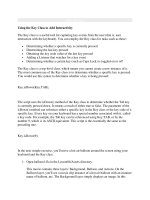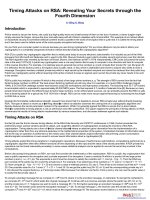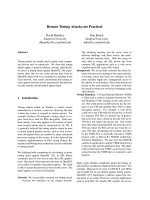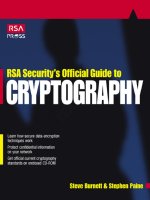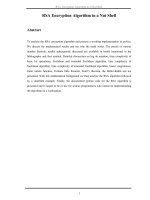Rsa en(no interactivity)
Bạn đang xem bản rút gọn của tài liệu. Xem và tải ngay bản đầy đủ của tài liệu tại đây (2.76 MB, 23 trang )
Functionality of the
RSA cipher
CrypTool Team
November 2010
Cryptography and what you need it for
• Sending encrypted messages has always played a major role in the history of humanity.
In each era there has been important information which had to be kept secret from
other people.
• Especially in today's society, in the age of internet, it is important to be aware of data security.
Data reaches their receiver indirectly
by passing between several servers.
At each node, the data can be captured,
read and even changed.
Modern cryptography is about securing this data.
2
Introductory example: Caesar cipher
• One of the first ways of encrypting a message was the Caesar cipher. The method got
its name from the ancient emperor Julius Caesar, who used it 2000 years ago to encrypt
secret messages to his generals.
• Here you can see how it works:
Plaintext
This is a secret
information!
Write out the alphabet twice in two concentric circles. Offset the letters of
the inner circle from the outer one by a certain amount.
3
Introductory example: Caesar cipher
• One of the first ways of encrypting a message was the Caesar cipher. The method got
its name from the ancient emperor Julius Caesar, who used it 2000 years ago to encrypt
secret messages to his generals.
• Here you can see how it works:
Plaintext
Chipertext
This is a secret
information!
Wklv
Vjku
Uijt ku
lv
jt b
dc tfdsfu
vhfuhw
ugetgv
kphqtocvkqp!
jogpsnbujpo!
lqirupdwlrq!
Now each letter in the plaintext will be replaced by its corresponding letter
in the inner circle. That’s how you get the ciphertext.
4
Introductory example: Caesar cipher
• One of the first ways of encrypting a message was the Caesar cipher. The method got
its name from the ancient emperor Julius Caesar, who used it 2000 years ago to encrypt
secret messages to his generals.
• Here you can see how it works:
Plaintext
Chipertext
This is a secret
information!
Wklv
Vjku
Uijt ku
lv
jt b
dc tfdsfu
vhfuhw
ugetgv
kphqtocvkqp!
jogpsnbujpo!
lqirupdwlrq!
As there are limited possibilities (only 26 possibilities of different chipertexts),
this cipher is quite easy to break.
5
Introductory example: Caesar cipher
• One of the first ways of encrypting a message was the Caesar cipher. The method got
its name from the ancient emperor Julius Caesar, who used it 2000 years ago to encrypt
secret messages to his generals.
• Here you can see how it works:
!
6
Plaintext
Chipertext
This is a secret
information!
Wklv
Vjku
Uijt ku
lv
jt b
dc tfdsfu
vhfuhw
ugetgv
kphqtocvkqp!
jogpsnbujpo!
lqirupdwlrq!
Do you want to try this cipher on your own text?
You can try it here.
Model of the RSA cipher
• The goal is to achieve a safe means of communication.
"Safe" in this case means that even if a message is intercepted, it should not be possible
for an attacker to read the message.
• How can we realize this security? A modern solution is the RSA cipher.
• The idea of the cipher is as follows:
Each participant has a padlock with a matching key.
7
Model of the RSA cipher
• The goal is to achieve a safe means of communication.
"Safe" in this case means that even if a message is intercepted, it should not be possible
for an attacker to read the message.
• How can we realize this security? A modern solution is the RSA cipher.
• The idea of the cipher is as follows:
The main idea is to separate the padlock from the key. You should publicize copies
of your padlock, as opposed to your key, which you should keep secret.
8
Model of the RSA cipher
• The goal is to achieve a safe means of communication.
"Safe" in this case means that even if a message is intercepted, it should not be possible
for an attacker to read the message.
• How can we realize this security? A modern solution is the RSA cipher.
• The idea of the cipher is as follows:
Now someone who wants to send you a message is able
to encode his or her message with your padlock.
9
Model of the RSA cipher
• The goal is to achieve a safe means of communication.
"Safe" in this case means that even if a message is intercepted, it should not be possible
for an attacker to read the message.
• How can we realize this security? A modern solution is the RSA cipher.
• The idea of the cipher is as follows:
Then the message can be sent in public, as only the right recipient
will be able to open the padlock with the appropriate key.
10
The essential problem
• The RSA cipher is the electronic implementation of the model described before.
• The cipher got its name from its inventors: Rivest, Shamir and Adleman.
• The algorithm is based on an underlying mathematical problem. Specifically, it is the problem
of factoring a given large number into prime numbers.
• When you have a number that is a product of large prime numbers, it is quite hard to find its
decomposition. Still today no one has found a fast and effective way of finding the factors.
The security of RSA is based on this difficulty.
3347807169895689878604416984821269081770479498371376856891
2431388982883793878002287614711652531743087737814467999489
∗=
3674604366679959042824463379962795263227915816434308764267
6032283815739666511279233373417143396810270092798736308917
∗=
1230186684530117755130494958384962720772853569595334792197
3224521517264005072636575187452021997864693899564749427740
6384592519255732630345373154826850791702612214291346167042
9214311602221240479274737794080665351419597459856902143413
Bit length: 768
!
11
Decimal length: 232
Current PCs can quickly factor numbers with about 80 digits.
Therefore, practical RSA implementations must use moduli with at least 300 digits
to achieve sufficient security.
How does the RSA cipher work?
To understand how RSA cipher works you need some basic mathematical
concepts. We will explain this in the next slides.
1
The modulo operator
2
Euler‘s totient function
3
Euler-Fermat theorem
12
𝜑 𝑛 = # 𝑎 𝜖 ℕ 𝑔𝑔𝑇 𝑎, 𝑛 = 1, 1 < 𝑎 < 𝑛}
𝜑 𝑛 = # 𝑎 𝜖 ℕ 𝑔𝑔𝑇 𝑎, 𝑛 = 1, 1 < 𝑎 < 𝑛}
Mathematical basics - 1
The modulo operator
• This sign is the modulo operator. With the modulo operation you are
interested in the remainder left over from division with an integer number.
• To get a better idea, take a look at the following:
16 ≡ 1 𝑚𝑜𝑑 5
Five people want to share a cake which is already cut into 16 pieces.
Each of them can get three pieces of cake, but one will be left over.
The modulo operator calculates precisely this remainder.
13
Mathematical basics - 1
The modulo operator
• This sign is the modulo operator. With the modulo operation you are
interested in the remainder left over from division with an integer number.
• To get a better idea, take a look at the following:
Mathematical definition
𝑎 ≡ 𝑏 𝑚𝑜𝑑 𝑁
means that there exists an integer number
𝑎 = 𝑘 ∗such
𝑁+𝑏
that 𝑎 can
represented
as
≡ 𝑏be𝑚𝑜𝑑
𝑁
𝑎 = 𝑘∗𝑁+𝑏
An example
The modulo operator is commutative with the basic
arithmetic operations. For example it does not matter
whether you first multiply
18 ∗ 13 = 234 ≡ 4 𝑚𝑜𝑑 10
or first calculate the modulus and then multiply:
18 ∗ 13 ≡ 8 ∗ 3 𝑚𝑜𝑑 10
= 24 𝑚𝑜𝑑 10 ≡ 4 𝑚𝑜𝑑 10
with the condition that: 0 ≤ 𝑏 ≤ 𝑁 − 1
!
14
= 𝑘.∗ 𝑁 + 𝑏
We are not interested in the value𝑎 of
The important part is its existence.
?
Further information can be found in the
CrypTool Script (chap. 4.4).
Mathematical basics - 2
Euler’s totient function
𝑛 an
=integer
# 𝑎𝜑𝜖 ℕ
𝑔𝑔𝑇
𝑎,
= 𝑔𝑔𝑇
1, 1whole
<𝑎,𝑎𝑁<
𝑛}
• Euler’s totient function 𝜑 of
how
numbers
are both
𝑁 counts
=# 𝑎
𝜖𝑛 ℕmany
= 1 𝑢𝑛𝑑
1 < coprime
𝑎 < 𝑁}
to
𝜑 𝑁 .𝑎,=𝑁# =
𝑎 𝜖1 ℕ𝑢𝑛𝑑
𝑔𝑔𝑇
𝜑 𝑁 and
= #smaller
𝑎 𝜖 ℕ than
𝑔𝑔𝑇
1 <𝑎,𝑎𝑁< =
𝑁}1 𝑢𝑛𝑑 1 < 𝑎 < 𝑁}
• Here how the formula looks:
𝜑 𝑁 = # 𝑎 𝜖 ℕ 𝑔𝑐𝑑 𝑎, 𝑁 = 1 𝑎𝑛𝑑 1 ≤ 𝑎 < 𝑁}
?
Important properties
Example
Given a number which is product of two factors
𝑎 and 𝑏 :
Suppose we want to calculate 𝜑 10 .= #{1,3,7,9} = 4
First we find the factor of 10 := 5 ∗ 2
𝜑 𝑎∗𝑏 = 𝜑 𝑎 ∗𝜑 𝑏
Given a prime number 𝑝 :
𝜑 𝑝 =𝑝−1
10 = 5 ∗ 2
Becauseo
10 10
= 5=∗and
52∗ 2 are primes, we can use
the formula given to the left:
𝜑 10 = 𝜑 5 ∗ 𝜑 2 = 4 ∗ 1 = 4
Therefore , given a number composed of two
𝑛 ==
𝑝 ∗#𝑞𝑎
primes,
: 𝜖 ℕ 𝑔𝑔𝑇 𝑎, 𝑁 = 1 𝑢𝑛𝑑 1 < 𝑎 < 𝑁}
𝜑 𝑁
𝜑 5 = #{1, 2, 3, 4} = 4
𝜑 𝑁 = 𝜑 𝑝 ∗ 𝑞 = 𝜑 𝑝 ∗ 𝜑 𝑞 = 𝑝 − 1 (𝑞 − 1)
𝜑 10 = #{1, 3, 7, 9} = 4
15
𝜑 2 = #{1} = 1
Näheres siehe CrypTool-Skript, Kap 4.8.2
4
Mathematical basics - 3
The Euler-Fermat theorem
• The last basic equation is the Euler-Fermat theorem.
𝑔𝑔𝑇(𝑎,
𝑁):1= 1
Given
two
coprime
numbers
and
𝑎𝜑(𝑛)
= 1
𝑚𝑜𝑑
𝑛 , wenn
𝑔𝑔𝑇(𝑎,
𝑛) =
𝑎𝜑(𝑁) ≡ 1 𝑚𝑜𝑑 𝑁 ,
=
Modulus calculations operate in the
finite set {0, 1, … , 𝑁 − 1} .
A function is called cyclic if, after
repeated application, the results
2
7 repeat
∗ 72themselves
= 49 ∗ 49
≡this
9 ∗set.
9=
within
1
8
2
81 ≡ 1 𝑚𝑜𝑑 10
For example, one such cyclic function
is multiplication with a fixed base.
We will choose the numbers 𝑎 = 3 and
𝑎 = 7 as the fixed bases. We can multiply
each number by itself until we reach it
again. In our example 𝑁 = 10
with 𝜑 𝑁 = 4 .
16
0
9
𝑎=3
𝑎=7
7
6
3
4
5
3
9
7
1
3
7
9
3
1
7
The cycles generated by
this operation both have length 4 ,
which is exactly 𝜑 𝑁 +
. 1
If you multiply a number 𝑎 =
by3itself, you
will, with absolute certainty, reach 𝑎. = 3
+1
again in at most 𝜑 𝑁 steps.
You can verify this by multiplying both
sides of the formula above by 𝑎 .= 3
With these basic equations we can
start looking at the actual cipher.
Step 1: Generate the keys
• We separate the RSA cipher algorithm into three different steps which will be explained
on the following slides.
• First we have to generate our RSA keys. This step must be done only once as an initial step.
Formal
Example
11.
Choose two primes 𝑝 and 𝑞 with 𝑝 ≠ 𝑞
11.
𝑝 =and
𝑞13
= 7𝑞 = 7
Suppose we select 𝑝 = 13
22.
Calculate their product: 𝑁 = 𝑝 ∗ 𝑞
22.
Thus: 𝑁 = 13 ∗ 7 = 91
33.
Calculate the value of Euler’s totient
function of 𝑁
𝜑 𝑁 = 𝜑 𝑝 ∗ 𝑞 = 𝑝 − 1 (𝑞 − 1)
3
𝜑 91 = 𝜑 13 ∗ 7 = 13 − 1 (7 − 1) = 72
43.
Suppose we choose 𝑒 = 5, because:
44.
55.
Choose a number 𝑒 between 1 and 𝑁 − 1
54.
which is coprime to 𝜑 𝑁 = 𝜑 𝑝 ∗ 𝑞 = 𝑝 − 1 (𝑞 − 1)
Find another number 𝑑 ∗where
𝑒 ≡ 1 𝑚𝑜𝑑 𝜑 𝑁
𝑑 ∗ 𝑒 ≡ 1 𝑚𝑜𝑑 𝜑 𝑁
𝑔𝑐𝑑 5, 72 = 1
We will select 𝑑 = 29 as thus:
𝑑 ∗ 𝑒 = 145 = 2 ∗ 72 + 1 ≡ 1 𝑚𝑜𝑑 72
?
Here you can get more information on
how to find an appropiate number 𝑑 = 29
(by means of the extended Euclidean algorithm)
(𝑒, 𝑁) is the public RSA key.
(𝑑, 𝑁) is the private key.
17
You can find further details in the CrypTool script, chap. 4.10.3
Step 2: Encrypt messages
• Now we have the requirements to encrypt and decrypt messages.
• First we must convert the letters into numbers to be able to use them in our calculations.
For example you can use the following substitution:
A
B
C
D
…
Z
01
02
03
04
…
26
Formal
Example
To encrypt a message we have to calculate
We shall continue our example by encoding
the word “SECRET”:
𝐶 ≡ 𝐾 𝑒 𝑚𝑜𝑑 𝑁
𝑁 𝐶 is the
Here 𝐾 is the converted message𝑒and
𝑒𝐶 𝑁 𝐶
encoded text, the ciphertext. The numbers 𝑒 𝑁
and
are taken from the public RSA key.
!
18
The presented cipher is simplified.
Further information is provided in the
next slides.
Letters
Numbers
S
E
C
R
E
T
19 05 03 18 05 20
Now we take the first letter S = 19 and encrypt
it by using the public key: (5, 91)
𝐾 𝑒 = 195 = 19 ∗ 192 2 = 19 ∗ 361 2
≡ 19 ∗ (88)2 ≡ 19 ∗ 9 = 171 = 80 𝑚𝑜𝑑 91
Following this pattern, ”SECRET“ is encrypted as
follows:
80 31 61 44 31 76
Step 3: Decrypt Messages
• The receiver gets the message now in its encrypted form only.
Formal
Example
To decipher the original message the receiver
needs to calculate the following:
The encrypted message is as follows:
30 31 61 44 31 76
𝐾 ≡ 𝐶 𝑑 𝑚𝑜𝑑 𝑁
Here 𝐾 will produce the plaintext. The values(𝑑, 𝑁)
and
𝑒 𝑁 are
𝐶 saved in the receiver’s private key (𝑑, 𝑁).
According to the formula given to left, he or she can
decipher by using his or her private key (29, 91) :
𝐶 𝑑 = 3029 = ⋯ ≡ 19 𝑚𝑜𝑑 91
The complete plaintext is obtained by calculating
accordingly for each value.
Nnumbers
Letters
?
19
Why do you get the plaintext by using these formulas?
You can learn the answer on the following slides.
19 05 03 18 05 20
S
E
C
R
E
T
Explanation of the formulas
• The following formulas explain why the receiver will obtain the plaintext from
the encrypted text.
• First we should examine the process of decryption more precisely.
Since 𝐶 = 𝐾 𝑒,
𝐶 𝑑 = (𝐾 𝑒 )𝑑 = 𝐾 𝑒∗𝑑
• Thus 𝑑 ∗ 𝑒 ≡ 1. 𝑚𝑜𝑑 𝜑 𝑁 , which is equivalent to 𝑑 ∗ 𝑒 = 1 + 𝑙 ∗ 𝜑(𝑁)
where
an
𝑑 ∗ 𝑒, =
1 + 𝑙 ∗is 𝜑(𝑁)
arbitrary integer number.
• We can then derive the following sequence of equations:
𝐾 𝑒∗𝑑 = 𝐾 1+𝑙∗𝜑 𝑁 = 𝐾 ∗ 𝐾 𝑙∗𝜑 𝑁 = 𝐾 ∗ (𝐾 𝜑 𝑁 )𝑙
• By means of Euler-Fermat theorem, 𝐾 𝜑 𝑁 ≡ 1 𝑚𝑜𝑑 𝑁, we get:
𝐾 ∗ (𝐾 𝜑 𝑁 )𝑙 ≡ 𝐾 𝑚𝑜𝑑 𝑁
• All in all we get the following:
𝑑
𝐶 ≡ 𝐾 𝑚𝑜𝑑 𝑁
20
By raising the ciphertext to a higher power,
we reobtain the plaintext.
Security of the cipher
• The given example was simplified to make the explanation clearer. If you were to use
the cipher as it was just explained, communication would be insecure.
S
E
C
R
E
T
19 05 03 18 05 20
30 31 61 44 31 76
.
E
.
.
E
.
By encoding each letter to one number, the resulting encryption will
be a one-to-one mapping: for each letter there is just one corresponding
number in the ciphertext.
So an easy way of attacking the ciphertext is by using a frequency analysis.
The idea is that there exists an unequal distribution of letters in each
language. In English the most frequent letter is the letter “E”, so you can
try to replace the most frequent number in the ciphertext with “E”.
• To avoid this problem, a possible solution is to combine several numbers into a block.
In our example we could unite it as follows an then encode it again in another manner:
SEC
RET
190503
180520
!
By combining several numbers to a block, we have to pay
𝑒 𝑁. 𝐶
attention in choosing our module
It has to be bigger than
the largest possible number in the block.
• In practice, RSA is not used to encrypt text blocks, but rather combined with a symmetric
cipher. In this case, RSA is only used to encrypt the key of the symmetric cipher
(Hybrid cryptosystem).
21
The factorization problem and RSA
• You may be asking yourself why all of this is based on the problem of factoring large numbers.
• We will explain this with the help of our example, as it is easy to find the factors of the number 𝑁: = 91
𝑁 = 91 = 13 ∗ 7 = 𝑝 ∗ 𝑞
𝐶 the connection
• As soon as you have the factorization, you can calculate 𝜑 𝑁 . By means of 𝑒 𝑁and
𝐶 the formula 𝑑 ∗ 𝑒 ≡ 1 𝑚𝑜𝑑 𝜑 𝑁 , you can easily find the number 𝑑, =
29 𝑒 𝑁with
29 is
of 𝑑 =
and
which
‒ together with 𝑁 ‒=the
91private
= 13 ∗key.
7 Once you have the private key you can decrypt the entire
ciphertext.
• No one has yet found a way to:
𝑁𝐶
• calculate 𝑑 with
help of
knowing the factorization of the number 𝑁. = 91 = 13 ∗ 7
∗ 𝑒 ≡the
1 𝑚𝑜𝑑
𝜑 𝑒𝑁without
• calculate the plaintext from the cipher without knowing the private key 𝑑 .∗ 𝑒 ≡ 1 𝑚𝑜𝑑 𝜑 𝑁
!
22
In fact, by knowing the factorization and the public key (𝑒, 𝑁) it is possible to
generate the private key. Therefore, the attacker could repeat the first step
of the process, the generation of the keys.
Further information and references
•
An open-source software tool for learning cryptographic ciphers and cryptanalysis
• />A thorough script with more information about the mathematical aspects of cryptography
• />Wikipedia article about cryptography in general
• />Wikipedia article about the RSA cipher
• />Online RSA encryption application (Dutch)
23

